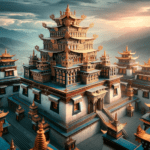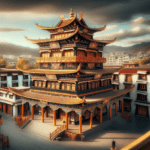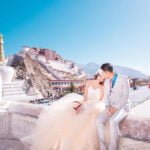Overview of Seqie Temple
Location and Historical Background: Seqie Temple, also known as se-che-dgon, is gracefully situated on the south side of Longping Village, Xinba Township, Longzi County. Originally belonging to the Nyingma sect before transitioning to the Gelug sect, the temple has undergone significant reconstruction over the years. In its heyday, it was home to 160 monks and was notably built by the eminent Tibetan monk Qiang Zeng Dorje Gyaltsen during the “Latter Hong Period.”
The Temple’s Architectural Splendor
Main Building – Dukang Hall: The centrepiece of Seqie Temple is the Dukang Hall, an east-facing, two-storied structure embodying the essence of Tibetan monastic architecture:
- Ground Floor: This level comprises a porch, sutra hall, Buddhist hall, and a Dharma Protector Temple, each serving a unique purpose in the temple’s religious practices.
- Porch: Covering 21 square meters, the porch features four columns and is adorned with murals of the Four Heavenly Kings and the Diagram of Reincarnation on its three walls, representing key elements of Buddhist cosmology.
- Sutra Hall: Located west of the porch, the Sutra Hall is a spacious area with a width of 24 meters and a depth of 16 meters. It contains eight columns arranged in a grid pattern, with a spacing of 2 meters by 2.8 meters. The central four columns support the upper floor, forming a patio-style shed for ventilation and lighting. The hall’s walls are decorated with brightly coloured murals, adding to its sacred ambience.
Buddha Hall and Mengye Bengpa Pagoda:
Following the Sutra Hall is the Buddha Hall, which enshrines statues of Sakyamuni Buddha, Infinite Light Buddha, Jampa Buddha, and others. The Mengye Bengpa Pagoda, a distinctive part of the temple complex, features a bowl-shaped body constructed with stone flakes. At its pinnacle sits a square box containing the remains of the Nyingma sect’s living Buddha Qiangzeng Dorje Gyaltsen, further cementing the temple’s spiritual and historical significance.
Seqie Temple, with its rich history and architectural magnificence, stands as a testament to the evolving traditions of Tibetan Buddhism. From its intricate murals to the sacred spaces within its walls, the temple offers a profound glimpse into the spiritual and cultural heritage of Tibet. Whether for religious study, architectural appreciation, or cultural exploration, Seqie Temple remains a significant and inspiring destination.
Highlights of the Seqie Temple’s Sutra Hall Murals
Captivating Murals in the Sutra Hall
East Wall: A Blend of Divinity and History
- Vajradhara Buddha: The southern part of the east wall is dedicated to the depiction of Vajradhara Buddha, a central figure in Tibetan Buddhism.
- Row Patterns: To the right of Vajradhara, the wall features three rows of intricate patterns. The middle row displays small Buddha statues in various poses, seated in lotus positions on lotus platforms. The upper and lower rows are adorned with figures from the Tubo Dynasty’s royal families and portraits of key figures from various Buddhist sects.
South Wall: An Array of Sacred Figures
- Amitayus Buddha Statues: The eastern section showcases a series of small Amitayus Buddha statues, numbering 100 in total.
- Dalai Lama Portraits: Moving westward, the wall features the first Dalai Lama, Gendun Drupa, and the second Dalai Lama, Gendun Gyatso, along with the three masters and disciples of Tsongkhapa.
- Protector and Savior Figures: Additional figures include the horse-riding protector Chang Xing and the rescuer of the Eighth Difficulty Mother. The wall is anchored by statues of Sakyamuni Buddha and small thousand Buddha figures.
West Wall: A Journey Through Time
- Early Murals (Nyingma Sect): In the northern section, early murals, occupying 8 square meters, are attributed to the Nyingma sect. These feature Master Padmasambhava and his eight incarnations.
- Late Murals (Gelugpa Period): The south-to-north direction showcases the Gelugpa period with depictions of Sakyamuni Buddha, the Sixteen Arhats, the Eight Tathagatas of the Medicine Master, and narratives of Sakyamuni’s life, along with the “Two Saints and Six Ornaments” (Atisha, Zhongdunpa, and their path inheritance).
North Wall: Symbolic Imagery
- Small Thousand Buddha Statues: The west section displays numerous small thousand Buddha figures.
- Master Padmasambhava: The central section is adorned with an image of Master Padmasambhava.
- Three Row Patterns: In the east section, the middle row again features small thousand Buddha statues, while the upper and lower rows depict the lineage of the Tubo kings and main sects of the “Houhong period.”
Ceiling Murals: A Sky of Tibetan Icons
The ceiling of the sutra hall is embellished with murals including:
- Dalai Lama Portraits: Images of the first and second Dalai Lamas.
- Infinite Light Buddha and Tsongkhapa’s Disciples: Depictions of the Infinite Light Buddha and the three masters and disciples of Tsongkhapa.
- Other Significant Figures: The Savior of the Eighth Difficulty Mother, the founding living Buddha of the temple, and its reincarnation system are also portrayed.
In addition, the temple’s porch walls feature murals of the Four Heavenly Kings and the Diagram of Reincarnation.
Artistic Significance
These murals are celebrated for their bright and rich colors, and smooth and symmetrical brushwork, embodying the style characteristics of Tibetan murals from the Ming Dynasty period. They not only serve as a visual feast but also as a historical and spiritual narrative, capturing the essence of Tibetan Buddhist art and iconography.














